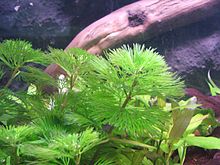Cabombaceae
You can help expand this article with text translated from the corresponding article in Spanish. (December 2009) Click [show] for important translation instructions.
|
| Cabombaceae Temporal range: (likely) Mid-Cretaceous–Present
| |
|---|---|

| |
| Scientific classification | |
| Kingdom: | |
| (unranked): | |
| Order: | |
| Family: | Cabombaceae |
| genera | |
Cabombaceae is a family of aquatic, herbaceous flowering plants.[3] The family is recognised as distinct in the Angiosperm Phylogeny Group III system (2009). The family consists of two genera of aquatic plants, Brasenia and Cabomba, totalling half-a-dozen species.[4] flowering plant lineages.
Members of the Cabombaceae are all aquatic, living in still or slow moving waters of temperate and tropical North and South America, Europe, Asia, Africa, and Australia. Although found on all continents, the plants tend to go in relatively restricted ranges.[5]
The family has an extensive fossil record from the Cretaceous with plants that exhibit affinities to either Cabombaceae or Nymphaceae occurring in the Early Cretaceous.[5] One such likely Cretaceous member is the genus Pluricarpellatia, found in rocks 115 million years old in what is now Brazil.[2]
The APG system of 1998 included this family in the water lily family Nymphaeaceae, as did the APG II system, of 2003 (optionally). The APG III system of classification separated the family Cabombaceae from the family Nymphaceae.[6][7] The family is part of the order Nymphaeales, which is one of the most basal flowering plant lineages.
References
- ^ Angiosperm Phylogeny Group (2009), "An update of the Angiosperm Phylogeny Group classification for the orders and families of flowering plants: APG III", Botanical Journal of the Linnean Society, 161 (2): 105–121, doi:10.1111/j.1095-8339.2009.00996.x, retrieved 2010-12-10
- ^ a b Stevens, Peter F. "Cabombaceae". APWeb. Retrieved 2013-12-01.
- ^ Watson, L.; Dallwitz, M. J. "The families of flowering plants, Cabombaceae". Retrieved 2012-12-01.
- ^ Brgaard, Marian. "The genus Cabomba (Cabombaceae) - a taxonomic study". Nordic Journal of Botany. 11 (2): 179–203. doi:10.1111/j.1756-1051.1991.tb01819.x.
- ^ a b Friis, Else Marie; Crane, Peter R.; Pederses, Kaj Raunsgaard (2011). Early Flowers and Angiosperm Evolution. Cambridge University Press. 9781139123921,.
{{cite book}}: CS1 maint: extra punctuation (link) - ^ Iles, WJD (2014). "Reconstructing the age and historical biogeography of the ancient flowering-plant family Hydatellaceae (Nymphaeales)". BMC Evolutionary Biology. 14 (1): 102. doi:10.1186/1471-2148-14-102.
{{cite journal}}: CS1 maint: unflagged free DOI (link) - ^ Saarela, JM (2007). "Hydatellaceae identified as a new branch near the base of the angiosperm phylogenetic tree". Nature. 446 (7133): 312–315. doi:10.1038/nature05612. PMID 17361182.
- Simpson, M.G. Plant Systematics. Elsevier Academic Press. 2006.
- Iles, W.J.D.; et al. (2014). "Reconstructing the age and historical biogeography of the ancient flowering-plant family Hydatellaceae (Nymphaeales)". BMC Evolutionary Biology. 14 (1): 102. doi:10.1186/1471-2148-14-102.
{{cite journal}}: CS1 maint: unflagged free DOI (link) - Saarela, J.M.; et al. (2007). "Hydatellaceae identified as a new branch near the base of the angiosperm phylogenetic tree". Nature. 446 (7133): 312–315. doi:10.1038/nature05612. PMID 17361182.
External links
- Cabombaceae in L. Watson and M.J. Dallwitz (1992 onwards). The families of flowering plants: descriptions, illustrations, identification, information retrieval. Version: 3 May 2006. http://delta-intkey.com
- Cabombaceae in the Flora of North America
- Cabombaceae in the Flora of China
- NCBI Taxonomy Browser
 Data related to Cabombaceae at Wikispecies
Data related to Cabombaceae at Wikispecies
